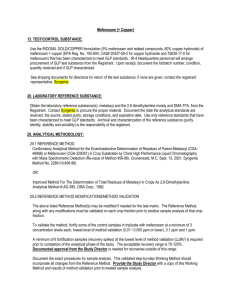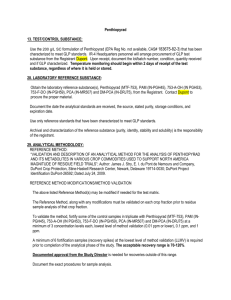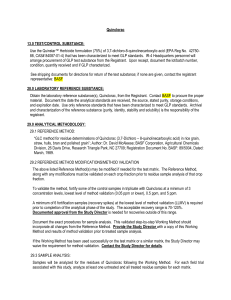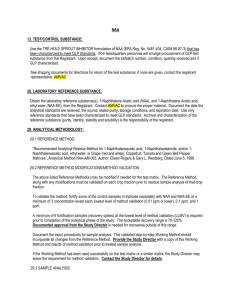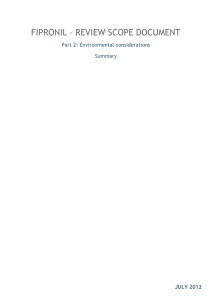FIPRONIL - IR
advertisement
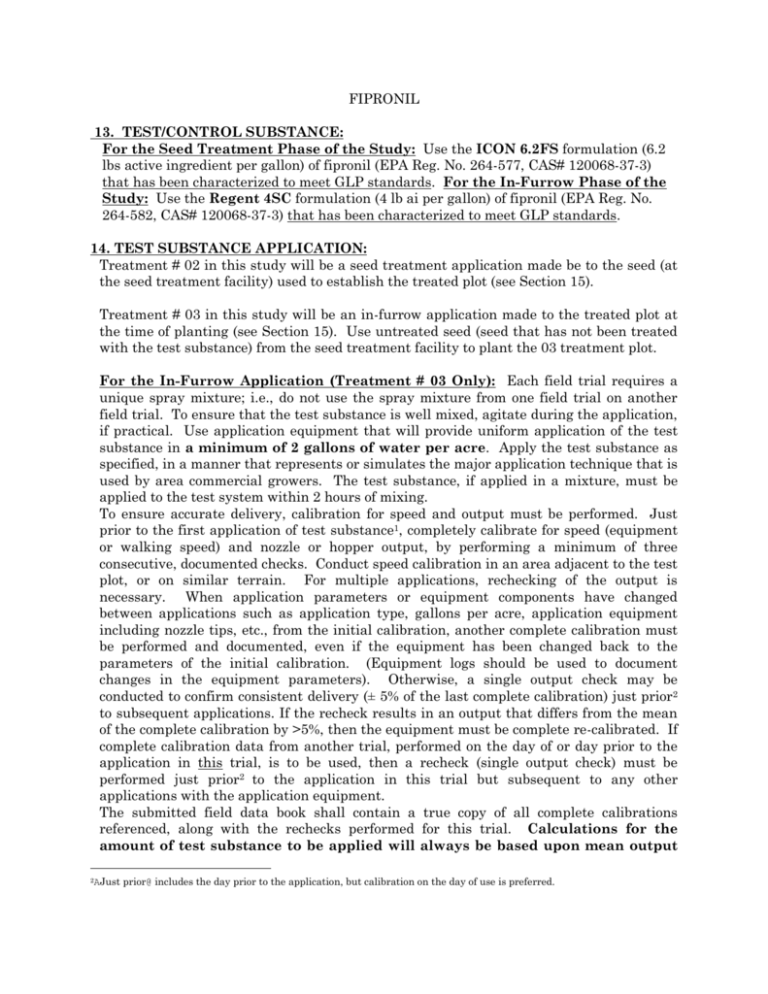
FIPRONIL 13. TEST/CONTROL SUBSTANCE: For the Seed Treatment Phase of the Study: Use the ICON 6.2FS formulation (6.2 lbs active ingredient per gallon) of fipronil (EPA Reg. No. 264-577, CAS# 120068-37-3) that has been characterized to meet GLP standards. For the In-Furrow Phase of the Study: Use the Regent 4SC formulation (4 lb ai per gallon) of fipronil (EPA Reg. No. 264-582, CAS# 120068-37-3) that has been characterized to meet GLP standards. 14. TEST SUBSTANCE APPLICATION: Treatment # 02 in this study will be a seed treatment application made be to the seed (at the seed treatment facility) used to establish the treated plot (see Section 15). Treatment # 03 in this study will be an in-furrow application made to the treated plot at the time of planting (see Section 15). Use untreated seed (seed that has not been treated with the test substance) from the seed treatment facility to plant the 03 treatment plot. For the In-Furrow Application (Treatment # 03 Only): Each field trial requires a unique spray mixture; i.e., do not use the spray mixture from one field trial on another field trial. To ensure that the test substance is well mixed, agitate during the application, if practical. Use application equipment that will provide uniform application of the test substance in a minimum of 2 gallons of water per acre. Apply the test substance as specified, in a manner that represents or simulates the major application technique that is used by area commercial growers. The test substance, if applied in a mixture, must be applied to the test system within 2 hours of mixing. To ensure accurate delivery, calibration for speed and output must be performed. Just prior to the first application of test substance1, completely calibrate for speed (equipment or walking speed) and nozzle or hopper output, by performing a minimum of three consecutive, documented checks. Conduct speed calibration in an area adjacent to the test plot, or on similar terrain. For multiple applications, rechecking of the output is necessary. When application parameters or equipment components have changed between applications such as application type, gallons per acre, application equipment including nozzle tips, etc., from the initial calibration, another complete calibration must be performed and documented, even if the equipment has been changed back to the parameters of the initial calibration. (Equipment logs should be used to document changes in the equipment parameters). Otherwise, a single output check may be conducted to confirm consistent delivery (± 5% of the last complete calibration) just prior2 to subsequent applications. If the recheck results in an output that differs from the mean of the complete calibration by >5%, then the equipment must be complete re-calibrated. If complete calibration data from another trial, performed on the day of or day prior to the application in this trial, is to be used, then a recheck (single output check) must be performed just prior2 to the application in this trial but subsequent to any other applications with the application equipment. The submitted field data book shall contain a true copy of all complete calibrations referenced, along with the rechecks performed for this trial. Calculations for the amount of test substance to be applied will always be based upon mean output 2AJust prior@ includes the day prior to the application, but calibration on the day of use is preferred. calculated from the most recent complete calibration data, not on the recheck results. Record actual application pass times in the field notebook and verify the accuracy of the application against the expected (calculated) results. The application is considered acceptable if the accuracy is within -5% and +10% of the protocol specified application rate. If the application did not meet this range, the Study Director must be notified of this deviation before proceeding with this trial. 23B. SEED TREATMENT LABORATORY PERSONNEL SEED TREATMENT RESEARCH DIRECTOR/SEED TREATMENT SITE: Pat McFadden, Gustafson R&D Center, 15012 County Rd. 22, McKinney, TX 75070, Tel. No.: (800) 413-9927, FAX# 972-542-0821; e-mail: patmcfad@gustafson.com Note: The seed will be treated under GLP guidelines using GLP characterized test substance and a detailed summary report will be prepared and submitted to IR-4 Headquarters for this phase of the study. 28. LABORATORY REFERENCE SUBSTANCE: Obtain the laboratory reference substance(s), fipronil, MB45950, MB46136 and MB46513, from the Registrant. Contact Mr. J. Thomas Wofford, BASF, (919) 5472223, FAX# 919-547-2402; e-mail: wofforj@basf.com to procure the proper material. Document the date the analytical standards are received, the source, stated purity, storage conditions, and expiration date. Use only reference standards that have been characterized to meet GLP standards. Archival and characterization of the reference substance (purity, identity, stability and solubility) is the responsibility of the registrant. 29. ANALYTICAL METHODOLOGY: REFERENCE METHOD: Analytical Method for the Determination of Fipronil and its Metabolites (M&B45950, M&B46136, M&B46513 and RPA 200766) in Cereal, Vegetable and Fruit. Method: AGR/MOA/FIP11A, December 1994. OR Insecticides, Fipronil: Analytical Method for the Determination of Fipronil and its Metabolites in Corn, Cotton, Potato & Rice Substrates (Revised January 1998), Jan 12, 1998, Rhone Poulenc Ag. Company. REFERENCE METHOD MODIFICATIONS/METHOD VALIDATION The above listed Reference Method(s) may be modified if needed for the test matrix. The Reference Method, along with any modifications must be validated on each crop fraction prior to residue sample analysis of that crop fraction. To validate the method, at a minimum fortify and analyze some of the control samples in triplicate with fipronil, MB45950, MB46136 and MB46513 and at a minimum of three concentration levels, the lowest level of method validation (LLMV, 0.005 ppm or lower), 0.05 ppm and 1 ppm for each compound (a single sample may be fortified with all 4 analytes). A minimum of 6 fortification samples (recovery spikes) at the lowest level of method validation (LLMV) is required prior to completion of the analytical phase of the study. The acceptable recovery range is 70-120%. Documented approval from the Study Director is needed for recoveries outside of this range. Document the exact procedures for sample analysis. This validated step-by-step Working Method should incorporate all changes from the Reference Method. Provide the Study Director with a copy of this Working Method and results of method validation prior to treated sample analysis. If the Working Method has been used successfully on the test matrix or a similar matrix, the Study Director may waive the requirement for method validation. Contact the Study Director for details. SAMPLE ANALYSIS: Samples will be analyzed for the residues of fipronil, MB45950, MB46136 and MB46513 following the Working Method. For each field trial associated with this study, analyze at least one untreated and all treated residue samples for each matrix. Contact the Study Director if residues above the lowest level of method validation for each matrix are detected in the untreated samples. Any changes or modifications to the Working Method require Study Director approval. Whenever possible, notify the Study Director prior to occurrence. Any change or modification to the Working Method should be documented in the raw data and discussed in the final report. A typical analytical set (or run) should consist of calibration standards, untreated sample(s), concurrent recovery sample(s), and treated sample(s). Each analytical set must begin and end with a calibration standard. Additional calibration standards should be injected with sample analysis to ensure goodness of fit to the standard curve. Over the course of residue sample analysis, adequate concurrent recovery samples that bracket the actual residues should be analyzed. At least one concurrent fortification sample should be analyzed per analytical set. The Study Director should be immediately notified if concurrent recoveries deviate from the acceptable recovery range of 70% to 120%. All efforts will be made to resolve existing recovery problems before continuing forward with additional analytical sets. If residues in samples are above the highest Working Method validation concentration, additional recovery samples at levels above actual residues must be run in triplicate as soon as practical. STORAGE STABILITY ANALYSIS: As soon as possible after receipt of samples, a minimum of six sub-samples of the control shall be fortified with fipronil, MB45950, MB46136 and MB46513 at 0.1 ppm each (a single sample may be fortified with all 3 analytes). Three samples will be analyzed after the appropriate storage period (greater than or equal to the longest interval that an individual sample was stored between collecting the sample in the field/processing facility and analysis, unless otherwise specified by the Study Director). The remaining samples will be retained for long-term storage. If analysis of treated/control samples is completed within 30 days of harvest analysis of storage fortification samples may not be required. If appropriate, contact Study Director. STATISTICAL METHOD(S): Utilize regression analysis to determine the linearity of the standard curve (r2) or the goodness of fit if the standard curve is non-linear. Criteria for acceptance of the standard curve(s) or other statistical methods shall be determined by Laboratory Research Director and/or the Study Director and documented in the raw data.


